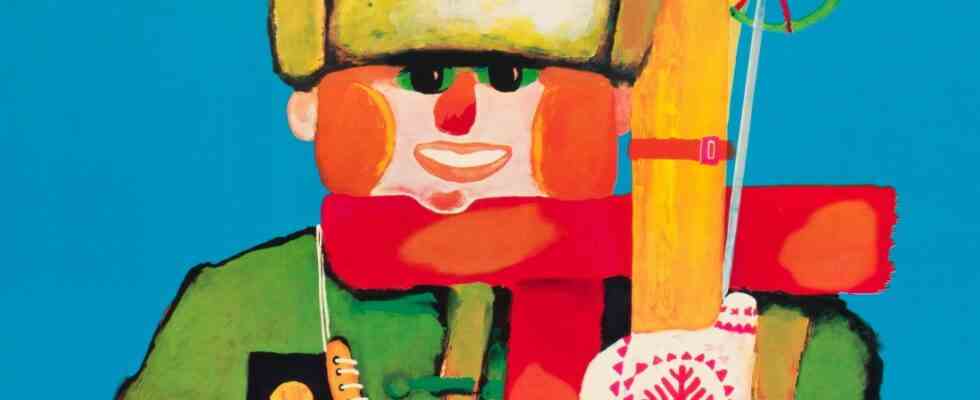Blue skies, snow-white mountains, bright sunshine – when you think of winter sports, these clichés come to mind very quickly. And admittedly, weaving down into the valley in such weather conditions can be wonderful. If it weren’t for those who thunder down the piste from midday, inspired by aprè-ski. But that wasn’t always the case. Long wooden boards instead of carving skis made of high-tech material, wool sweaters and knickerbockers instead of brightly colored functional clothes, that’s how it used to be.
The poster exhibition “Winter Magic” of the Neue Sammlung gives a very special look back at 100 years of winter sports. 24 poster reproductions from 1910 to the present day from the archive of the Design Museum are currently hanging on the glass facade of the Pinakothek der Moderne at the main entrance in Barerstraße and show the visual language with which international designers are mostly commissioned by winter sports areas, municipalities and tourist offices, but also the Swiss and the Deutsche Bahn promoted winter sports and tourism between 1910 and today.
Linus Rapp, curator of the open-air exhibition, which can also be viewed online on the Design Museum’s Instagram channel (@dieneuesammlung), came up with the idea of winter magic in the summer of all times. At that time, the approximately 25,000 posters in the collection began to be digitized. The fact that posters are rarely exhibited has to do with the sensitivity of paper to light. This is one of the reasons why reproductions are now being exhibited, identical in format and color quality to the originals.
An unknown poster painter, who drew with the signature AB, RHE, advertised winter sports in Zweisimmen, around 1920.
(Photo: Kai Mewes/The New Collection – The Design Museum)
Poster Carl Moos “3rd Alpine Ski Course”, 1910.
(Photo: Kai Mewes/The New Collection – The Design Museum)
Herbert Matter was one of the most important poster designers of his time: Pontresina, 1936.
(Photo: Kai Mewes/The New Collection – The Design Museum)
The development and success of the poster and of winter tourism show an astonishing parallel in the 19th century: Both had their big breakthrough there, both were aimed at a mass audience. The oldest exhibited motif by Carl Moos from 1910 advertised a ski course in Garmisch. The first poster designers were trained painters. Pictures and letters were hand-painted. Then photography was used more intensively, individual motifs were used to achieve effects, as the motif “Pontresina” by Herbert Matter from 1936 shows. With his innovative designs, the Swiss and American photographer became a pioneer in the development of graphic design.
In addition to painting, collage and photography, designers are increasingly using lettering and graphic reduction. One of the most prominent examples is the extremely reduced, black and white motif of Otl Aicher, the father of the Munich Olympic design. Germany, Austria and Scandinavia, among others, have a long tradition in poster design. After the Second World War, Poland experienced a lively poster tradition, an example is Marek Mosiński’s cheerfully figurative design from 1972 for the city of Karpazc at the gateway to the Giant Mountains. And in Switzerland, this continues to this day, as Denise Bertschi’s poster for “Winter Aid” proves.
Whoever has won a poster from Mirko Borsche in the New Collection’s hands-on campaign on Instagram (#WinterzauberDNS) will be announced on Wednesday.
Winter Magic, Pinakothek der Moderne, until Feb. 26, viewable around the clock, Guides: Thu, Jan. 19 and Thu, Feb. 16, each at 6.30 p.m

